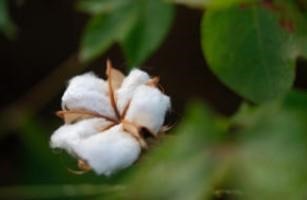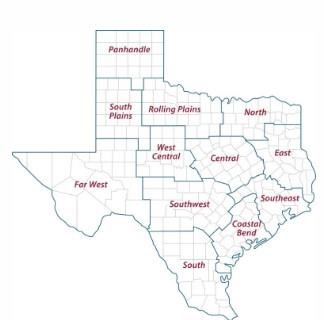Cotton futures rose rapidly over recent weeks as speculators began buying for potentially big profits based on expectations that prices would go up, according to a Texas A&M AgriLife Extension Service expert.

Cotton prices are much higher than this time last year and could present good selling opportunities for producers. (Texas A&M AgriLife photo by Laura McKenzie)
The rally has been good for Texas cotton growers who have negotiated prices during the rally or who still have cotton to sell, said John Robinson, Ph.D., AgriLife Extension cotton marketing economist, Bryan-College Station. But he suspects the spike in buying and climbing prices is nearing the end.
Factors weighing on cotton prices
Robinson said the cotton price rally started three weeks ago when it became clear prices would be up and the number of futures contracts held by long speculators were targeting cotton. The speculative buying pushed prices higher, but he said it is unclear what negative cropping and production factors were pushing futures purchases.
Issues pushing the price increase could be rain in the U.S. Cotton Belt or problems with cotton crops in India or production issues in China, including import bans for cotton produced by Uyghur minorities in slave labor camps in northwestern parts of the country.
But those factors alone should not be enough to cause the 25-cent per pound price jump over the three weeks from the 80-cent to 90-cent per pound range to $1.14 per pound for December futures. Robinson said conditions are bullish for cotton with strong demand, but the supply side and what is creating the strong demand are less clear.
Robinson said there is evidence for strong demand related to large buys of U.S. cotton based on the Phase 1 trade agreements that reduced or removed tariffs from the trade war with China.
Export demand for U.S. cotton triggered a 45-cent rally that took per-pound prices from 50 cents on April 1, 2020, to 95 cents by March 2021. That sustained price rally was driven by a global textile manufacturing ramp-up as mills reopened or increased capacity following initial COVID-19-related shutdowns.
But historically, price rally patterns influenced by speculation are volatile and short-lived, Robinson said.
“This week is the third week of the rally and there has been some selling,” he said. “So, this may be the top of the rally, but it is hard to predict based on what might be driving it to begin with. These speculators can unpredictably sell to take their profits or out of fear that the price could drop.”
Prices good for cotton growers
Robinson said Texas cotton growers should not expect prices to necessarily continue climbing.
Prices this time last year lingered in the 70-cent-per-pound range, Robinson said.
Around two-thirds of Texas cotton is sold through a cooperative that pools their supplies and negotiates the best prices for members throughout the year. Cash offers are available to those with unsold cotton in the field or who have bales at gins that could fetch premium prices based on lint quality and grades.
Many independent growers who locked in prices around 85 cents per pound may have seller’s remorse, but Robinson said they still did well.
“The pricing opportunities are there for growers who have unsold cotton,” he said. “Hopefully they have good yields and can take advantage of this rally. It is a good year for them to pay off debt, invest in their operation and save some money, especially producers who have had a tough couple of years.”
Robinson said there are ways for producers to begin planning for marketing their commodities and protecting their operation from the downside of potential prices in 2022. AgriLife Extension’s Master Marketing workshops focused on cotton provide information and education on how to maximize price opportunity and hedge against potential losses.
Consumers and cotton prices
Despite some reports, Robinson said higher cotton prices are not the reason consumers may see higher prices on cotton-dependent clothing and apparel. The 25-cents-per-pound rally may translate into millions of dollars to buyers and sellers of raw cotton but does not add that much to the cost of a t-shirt or a pair of jeans.
“The raw material is only a small part of the cost to create and market these products,” he said. “Manufacturing, shipping, labor and branding are all likely adding more to product costs compared to cotton. Fuel prices are higher. There are fewer trucks moving products and any disruptions to get finished products to market also add to the end cost to consumers.”
AgriLife Extension district reporters compiled the following summaries:

A map of the 12 Texas A&M AgriLife Extension districts.
CENTRAL
Rainfall amounts were variable. The entire month of September was extremely warm and dry for planting. Oats planted over the past month were just emerging. Some cotton harvest was being hampered by rainfall, but crop quality was not affected. Growers were securing corn seed for next year and doing some cultivation. Winter wheat plantings were expected to increase in areas that received moisture, but so far very little wheat had been planted. High nitrogen fertilizer costs and shortages could discourage some winter wheat plantings. Livestock were in good condition.
ROLLING PLAINS
More farming activity followed brief showers. Conditions were very dry, but farmers dry- planted wheat with little emergence after the rainfall. Conditions in Palo Pinto County were good following 5 inches of rain last week. Pastures looked to be going dormant. Feed supplementation began for cattle on pasture. Irrigated cotton looked very good, but dryland needed rain. Producers started digging peanuts.
COASTAL BEND
Temperatures were above-average with no rain, but field conditions remained wet with standing water in some fields. There was still some cotton to be harvested and many bales remained in fields awaiting pickup. Ratoon rice was heading out. Winter pasture preparation and planting continued. One last cutting of hay was being made or soon will be. Producers were reporting 2021 may be one of the best hay-making years in a long time. Livestock were doing well, and cattle work and shipping was active.
SOUTH PLAINS
Conditions were dry with no measurable rainfall. A few farmers started planting winter wheat and turned irrigation systems on to get fields established. Cotton bolls were continuing to open. Many farmers were making plans to defoliate in a couple of weeks if a hard freeze does not kill plants. Pumpkins were still being harvested, and local producers think they will finish up within the next 10 days. Several producers reported problems getting fertilizer. Cattle were in good condition.
PANHANDLE
Soil moisture was very short to short. Harvests continued with favorable weather. Light rains were reported, but much more was needed for wheat conditions to improve. The rainfall was beneficial for early planted wheat and fields planted ahead of the rain. Wheat planting continued in very dry soils, but rain will be necessary for germination. Rangelands were greening, but new growth may not occur before dormancy. Overall rangeland and pasture conditions were poor to fair for nearly all counties.
NORTH
Soil moisture remained very short to short for some counties and adequate for others. Some areas received substantial rains while other areas received very little, and more rainfall was in the forecast. Temperatures were in the 80s during the day and into the 60s at night. Pasture and rangeland conditions were good, but some areas were showing moisture stress and not growing. Corn, sorghum, soybeans and most of the cotton were harvested. Winter wheat was planted. Livestock were in good condition. Winter rye and other cool-season forages were emerging.
FAR WEST
Daytime temperatures ranged from the mid-80s to low 90s with overnight temperatures in the high 50s to low 60s. Isolated rainstorms and cooler temperatures persisted across higher elevation areas. High winds were blowing away dry sandy topsoil. Rangeland conditions were good across much of the district, but forage growth was slowing down with cooler temperatures. Producers reported some bacterial blight in cotton.
WEST CENTRAL
Farmers and ranchers prepared land for winter wheat and oats. Some planted and were reporting good emergence while others were waiting a little longer. Cotton harvest was about two weeks away from getting into full swing. Pecan producers were ready for harvest. Rangeland and pasture conditions were mostly fair.
SOUTHEAST
Soil moisture levels were very short to adequate in most areas. Grimes County received good rain but remained under a burn ban due to dry conditions. Pastures were wet and boggy from all the rain in some counties. Rangeland and pasture conditions ranged from very poor to excellent with fair conditions being most common. The main crop rice was pretty well finished, and there was some ratoon crop left, but blackbirds and hogs were eating it.
SOUTHWEST
Morning temperatures were cooler, and afternoon temperatures warm. Rangeland and pasture conditions improved where moisture was received. Most corn, sorghum and cotton fields were harvested. Hay was being cut and baled. Winter rye and other cool-season forages were emerging. Small grain plantings began and will increase as cooler temperatures arrive. There were no reports of fall armyworms yet. Livestock were in fair to good condition, and prices were higher for cattle, sheep and goats. Wildlife were in good condition as hunting season got underway. Supplemental feeding of livestock slowed.
SOUTH
Soil moisture conditions were very short to short in northern and western parts of the district and adequate in southern and eastern parts. Zapata County reported some rainfall. Temperatures cooled but were expected to reach 100 degrees again. Mulch was laid in preparation of strawberry planting. Peanut and cotton harvests continued. Cotton harvest was complete in many areas, and some modules remained in fields awaiting pickup. A few fields of fall-planted corn were tasseling. Most warm-season vegetable crops were finished for the season, and growers were putting in winter vegetables. Pecan orchards started harvesting, and the crop looked good. Pasture and rangeland conditions continued to decline due to lack of moisture but were greening up some in areas. Wheat and oats were planted for winter grazing but will need rainfall for germination. Oat food plots were planted for wildlife. Irrigated Bermuda grass was cut and baled. Cattle producers were busy working cattle and selling calves. Cattle were in good condition and markets were reporting average volumes and slight price dips for all classes. There were reports of declining cattle body condition scores. Stock tanks were full, and producers were providing supplemental feed for livestock and wildlife. Feed prices increased. Some hay producers were cutting and baling, and hay bales were $50-$65 per bale. Leaves were starting to drop from trees. Citrus looked better, and sugarcane fields looked to be in excellent shape. Some sugarcane was under irrigation, and a few citrus trees were showing fruit. The sesame harvest was complete, and onions will be planted soon. Some growers were plowing under stalks and performing fieldwork.
Source : tamu.edu